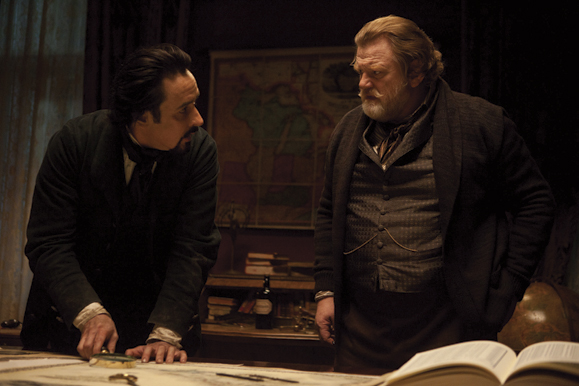Exploring a character forced to grapple with inner demons is a familiar task for actor John Cusack, who has portrayed quite a few anguished souls throughout his versatile film career. From his role as an existentially suffering puppeteer in Charlie Kaufman’s absurdist Being John Malkovich to his – not one but two – turns at playing troubled assassins (first in Grosse Pointe Blank, and again in War, Inc., which he also co-wrote and produced), it’s clear that Cusack is not one to skirt the darker aspects of the human condition. His latest turn toward the macabre is his portrayal of Edgar Allan Poe in April’s gory thriller The Raven, directed by James McTeigue.
For someone so drawn to the complex and disturbing, Cusack’s demeanor is quite calm. Asked about his fascination with such a morbid figure as Poe, his eyes light up, and he replies simply, “Oh, it’s fun, right?” before elaborating, “That’s Poe’s deal, that we’re all sort of attracted to the abyss. It’s poetic,” he grins. “Poe-etic.”
It would seem that all this exploration of the depths has served as kind of purging for Cusack. It’s a rare person who not only can understand despair, but can also find humor within it. “Around Halloween or the Day of the Dead,” he continues, “doesn’t everybody get into the supernatural, and the ghouls, and the underworld? Dreams and nightmares? It’s just an interesting headspace. It’s not something I want to stay in, but it’s certainly a fun place to visit once in a while – once a year, twice a year.”
Edgar Allan Poe, whose writings and mysterious life inspired the movie The Raven, had roots stretching from Baltimore, Maryland back to Dring, County Cavan, Ireland, where his great-grandfather grew up. Poe’s hometown of Baltimore serves as backdrop for the film, which also stars Brendan Gleeson as the disapproving father of Poe’s beloved. This entirely fictionalized account of Poe’s last days entertains the unsettling question of how a real-life serial killer might have gone about mimicking Poe’s grisliest stories. The movie’s answer? Accurately.
“There are not many writers who try to [delve into] their worst nightmares,” Cusack maintains. “But there’s a couple who want to go deeper in, and that’s just an interesting mind. [Poe] was this guy who wanted to embrace the nightmare.”
Cusack, like Poe, has a distant Irish background. Raised by politically active Irish Catholics in Chicago, he leads a life at once thoroughly individualistic – disregarding the mainstream in decisions both artistic and lifestyle – while still deeply rooted in family tradition.
Though he has plenty to be happy about (he recently received a star on the Hollywood Walk of Fame) Cusack seems most at ease when speaking about heavier topics. Censorship, for one, is something he believes does not belong in the arts. “I think the artist has got to get a free pass, because I don’t know how you can explore, or go down different roads if you’re going to judge them all the time. That imagery [of the unconscious] is not sanitized. It’s violent, and it’s lurid, and it’s perverse. Dreams can be that way.”
Though he identifies entirely as American, Cusack seems to be in touch with that certain entangling of melancholy and joy unique to the Celtic spirit. He reflects, “Poe was always talking about that space between waking and dreaming, sanity and insanity, life and death. He was always into that twilight space.”
And Cusack is himself a bit of a living paradox – this non-smoker who casually puffs on an electric cigarette, this relaxed figure with the venti coffee cup in hand – with those intense eyes hovering above that easy smile.
John Cusack on Poe and The Raven


Leave a Reply